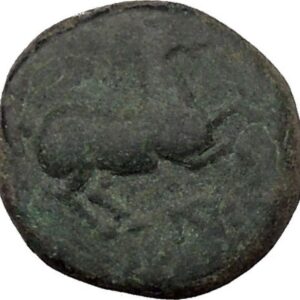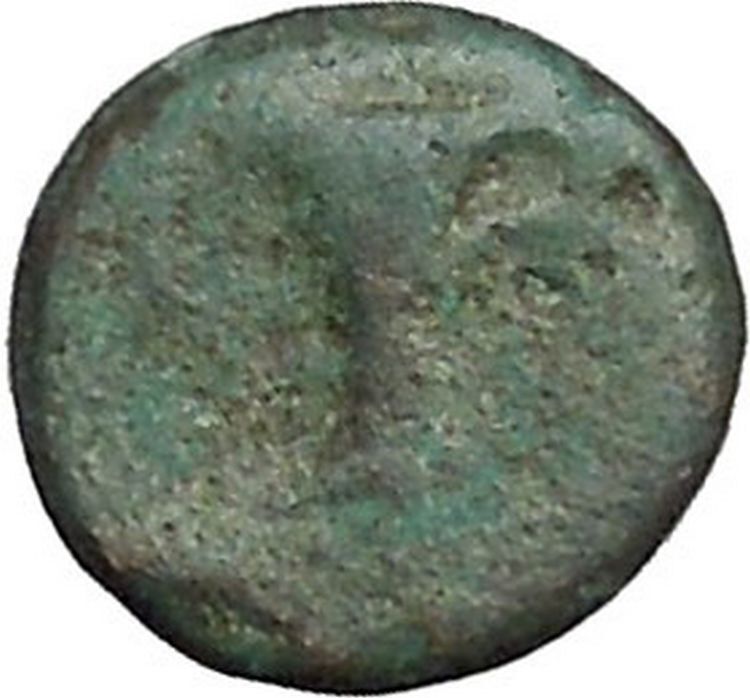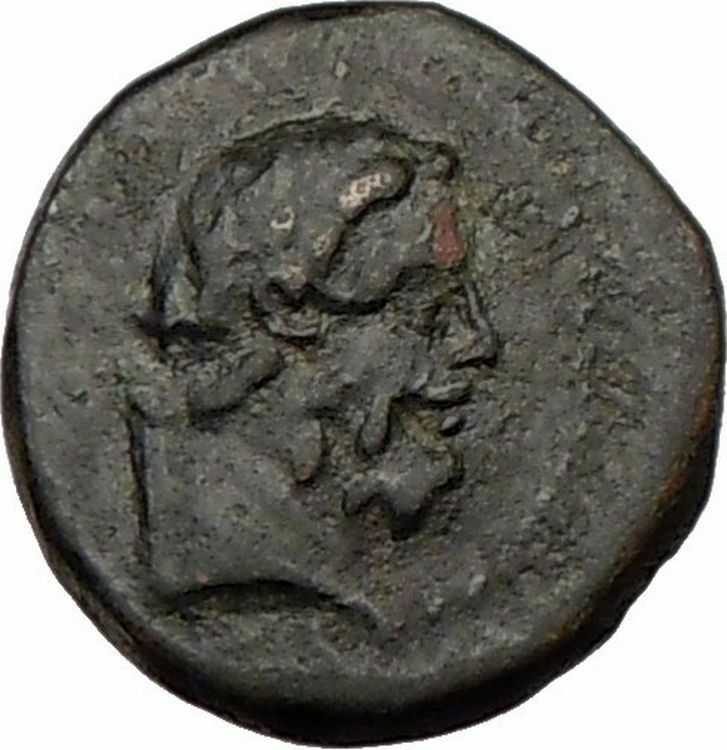|
Greek city of
Arpi in
Apulia
Bronze 21mm (7.90 grams) Struck circa 300-200 B.C.
Reference: Sear 569; B.M.C. 1.4; SNG ANS 636; SNG Cop. 603
ΔAIOY, Laureate head of Zeus left, thunderbolt behind.
Kalydonian (Calydonian) boar running right, spear-head above, APΠANOY in
exergue.
You are bidding on the exact
item pictured, provided with a Certificate of Authenticity and Lifetime
Guarantee of Authenticity.
In the
ancient Greek
religion, Zeus was the
“Father of Gods and men” (πατὴρ ἀνδρῶν τε θεῶν
τε)
who ruled the Olympians of
Mount Olympus
as a father ruled the family. He was the
god of sky
and
thunder
in
Greek mythology
.
His
Roman
counterpart is
Jupiter
and
Etruscan
counterpart is Tinia
.![The Jupiter de Smyrne, discovered in Smyrna in 1680[1]](https://upload.wikimedia.org/wikipedia/commons/thumb/c/c8/Jupiter_Smyrna_Louvre_Ma13.jpg/200px-Jupiter_Smyrna_Louvre_Ma13.jpg)
Zeus was the child of
Cronus
and
Rhea
,
and the youngest of his siblings. In most traditions he was married to
Hera, although, at the
oracle of Dodona
,
his consort was
Dione
:
according to the Iliad
,
he is the father of
Aphrodite
by Dione. He is known for his erotic escapades. These resulted in many godly and
heroic offspring, including
Athena
,
Apollo
and Artemis
,
Hermes
,
Persephone
(by Demeter
),
Dionysus
,
Perseus
,
Heracles
,
Helen of Troy
,
Minos
,
and the Muses
(by Mnemosyne
);
by Hera, he is usually said to have fathered
Ares,
Hebe
and Hephaestus
.
As
Walter Burkert
points out in his book, Greek Religion, “Even the gods who are not his
natural children address him as Father, and all the gods rise in his presence.”
For the Greeks, he was the
King of the Gods
,
who oversaw the universe. As
Pausanias
observed, “That Zeus is king in heaven is a saying common to all men”. In
Hesiod’s Theogony
Zeus assigns the various gods their roles. In the Homeric Hymns he is
referred to as the chieftain of the gods.
His symbols are the
thunderbolt
,
eagle
,
bull
,
and oak
.
In addition to his Indo-European inheritance, the classical “cloud-gatherer”
also derives certain iconographic traits from the cultures of the
Ancient Near East
,
such as the
scepter
.
Zeus is frequently depicted by Greek artists in one of two poses: standing,
striding forward, with a thunderbolt leveled in his raised right hand, or seated
in majesty.
The Calydonian Boar is one of the monsters of
Greek mythology
that had to be overcome by
heroes of the Olympian age. Sent by
Artemis
to ravage the region of
Calydon
in
Aetolia
because its king failed to honor her in
his rites to the gods, it was killed in the Calydonian Hunt, in which
many male heroes took part, but also a powerful woman,
Atalanta
, who won its hide by first wounding it
with an arrow. This outraged some of the men, with tragic results.
Strabo
was under the impression that the
Calydonian Boar was an offspring of the
Crommyonian Sow
vanquished by
Theseus
.

The Calydonian Hunt shown on a Roman frieze (Ashmolean
Museum,
Oxford
)
Importance in Greek mythology and art
The Calydonian Boar is one of the
chthonic
monsters in Greek mythology, each set
in a specific locale. Sent by Artemis to ravage the region of Calydon in
Aetolia
, it met its end in the Calydonian
Hunt, in which all the heroes of the new age pressed to take part, with the
exception of Heracles
, who vanquished his own Goddess-sent
Erymanthian Boar
separately. Since the mythic
event drew together numerous heroes—among whom were many who were venerated as
progenitors of their local ruling houses among tribal groups of
Hellenes
into Classical times—the Calydonian
Boar hunt offered a natural subject in classical art, for it was redolent with
the web of myth that gathered around its protagonists on other occasions, around
their half-divine descent and their offspring. Like the quest for the
Golden Fleece
(Argonautica)
or the Trojan War
that took place the following
generation, the Calydonian Hunt is one of the nodes in which much Greek myth
comes together.

Tondo of a
Laconian
black-figure cup
by the
Naucratis Painter
, ca. 555 BCE (Louvre)
Both Homer
and
Hesiod
and their listeners were aware of the
details of this myth, but no surviving complete account exists: some
papyrus
fragments found at
Oxyrhynchus
are all that survive of
Stesichorus
‘ telling; the myth repertory called
Bibliotheke
(“The Library”) contains the
gist of the tale, and before that was compiled the Roman poet Ovid told the
story in some colorful detail in his
Metamorphoses
.
Hunt
Oeneus (“wine man”) of
Calydon
, an ancient city of west-central
Greece
north of the
Gulf of Patras
, held annual harvest sacrifices
to the gods on the sacred hill. One year the king forgot to include Great “Artemis
of the Golden Throne” in his offerings Insulted, Artemis, the “Lady of the Bow”,
loosed the biggest, most ferocious boar imaginable on the countryside of
Calydon. It rampaged throughout the countryside, destroying vineyards and crops,
forcing people to take refuge inside the city walls (Ovid), where they began to
starve.
Oeneus sent messengers out to look for the best hunters in Greece, offering
them the boar’s pelt and tusks as a prize.

Roman marble sarcophagus from
Vicovaro
, carved with the Calydonian Hunt (Palazzo
dei Conservatori, Rome)

Meleager et Atalanta, after
Giulio Romano
.
Among those who responded were some of the
Argonauts
, Oeneus’ own son
Meleager
, and, remarkably for the Hunt’s
eventual success, one woman— the huntress
Atalanta
, the “indomitable”, who had been
suckled by Artemis as a she-bear and raised as a huntress, a proxy for Artemis
herself (Kerenyi; Ruck and Staples). Artemis appears to have been divided in her
motives, for it was also said that she had sent the young huntress because she
knew her presence would be a source of division, and so it was: many of the men,
led by Kepheus and Ankaios, refused to hunt alongside a woman. It was the
smitten Meleager who convinced them. Nonetheless it was Atalanta who first
succeeded in wounding the boar with an arrow, although Meleager finished it off,
and offered the prize to Atalanta, who had drawn first blood. But the sons of
Thestios, who considered it disgraceful that a woman should get the trophy where
men were involved, took the skin from her, saying that it was properly theirs by
right of birth, if Meleagros chose not to accept it. Outraged by this, Meleagros
slew the sons of Thestios and again gave the skin to Atalanta (Bibliotheke).
Meleager’s mother, sister of Meleager’s slain uncles, took the fatal brand from
the chest where she had kept it (see
Meleager
) and threw it once more on the fire;
as it was consumed, Meleager died on the spot, as the Fates had foretold. Thus
Artemis achieved her revenge against King Oeneus.

Woodcut illustration for
Raphael Regius
‘s edition of
Metamorphoses
,
Venice
, ca. 1518
During the hunt, Peleus
accidentally killed his host Eurytion.
In the course of the hunt and its aftermath, many of the hunters turned upon one
another, contesting the spoils, and so the Goddess continued to be revenged (Kerenyi,
114): “But the goddess again made a great stir of anger and crying battle, over
the head of the boar and the bristling boar’s hide, between
Kouretes
and the high-hearted
Aitolians
” (Homer,
Iliad
, ix.543).
The boar’s hide that was preserved in the Temple of
Athena Alae
at
Tegea
in
Laconia
was reputedly that of the Calydonian
Boar, “rotted by age and by now altogether without bristles” by the time
Pausanias
saw it in the second century CE. He
noted that the tusks had been taken to Rome as booty from the defeated allies of
Mark Anthony
by
Augustus
; “one of the tusks of the Calydonian
boar has been broken”, Pausanias reports, “but the remaining one, having a
circumference of about half a fathom, was dedicated in the Emperor’s gardens, in
a shrine of Dionysos”. The Calydonian Hunt was the theme of the temple’s main
pediment.
Arpi (Argyrippa or Argos Hippium) was an ancient city of
Apuliaia
,
Italy
, 20 mi. W. of the sea coast, and 5 mi. N.
of the modern Foggia
. The legend attributes its foundation to
Diomedes
, and the figure of a horse, which
appears on its coins, shows the importance of horse-breeding in early times in
the district. Its territory extended to the sea, and
Strabo
says that from the extent of the city
walls one could gather that it had once been one of the greatest cities of
Italy
. As a protection against the
Samnites
, Arpi became an ally of
Rome. In the war with
Pyrrhus
, the Arpani aided Rome with a
contingent of 4000 foot and 400 horse. Arpi remained faithful to Rome until
Rome’s defeat at the
battle of Cannae
, but the consul Quintus Fabius
Maximus, son of the famous Roman dictator
Quintus Fabius Maximus Verrucosus
, captured it
in 213 B.C., and it never recovered its former importance. It lay on a by-road
from Luceria
to
Sipontum
. No Roman inscriptions have, indeed,
been found here, and remains of antiquity are scanty. Foggia is its medieval
representative.
|





![The Jupiter de Smyrne, discovered in Smyrna in 1680[1]](https://upload.wikimedia.org/wikipedia/commons/thumb/c/c8/Jupiter_Smyrna_Louvre_Ma13.jpg/200px-Jupiter_Smyrna_Louvre_Ma13.jpg)








